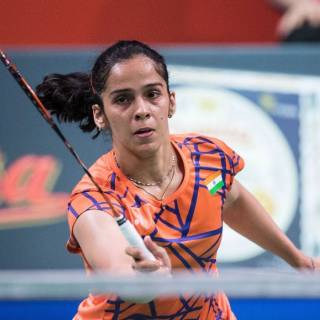Exactly six years to the day she won her maiden Denmark Open title, Saina Nehwal finished second-best despite a spirited fight in the final of the same tournament on Sunday. Saina lost 13-21, 21-13, 6-21 to World No. 1 Tai Tzu Ying, who has now won her last 11 matches against Saina.
The first two games were almost a mirror image of each other before Tai upped her game a couple of notches to dominate the decider.
Saina had been on a giant-killing run en route to the final, defeating World No. 2 Akane Yamaguchi and former World Champion and Olympic bronze medallist Nozomi Okuhara in the previous rounds.
However, the difference between playing Yamaguchi and Okuhara, as opposed to playing Tai, is that Saina had to go out of her comfort zone and aim for the lines against Tai, rather than play down the middle of the court -- the safer option -- as that doesn't work against the best player in the world.
What makes Tai unique is her ability to change the direction of rallies at will. Saina's strategy has often revolved around trying to attack Tai's backhand but that has not worked as Tai has the ability to hit backhand clears that are flat and deep -- almost unheard of in the women's game. Even as most women players are reliant on their forehand and deception to hit winners, Tai can hit clear winners off both wings, giving her an advantage over most players.
Tai led from start to finish in the opening and deciding game, a now-familiar pattern in her matches against Saina.
It was clear Saina was feeling the pressure as she committed unusual errors in the form of a long serve and a service fault for serving above the waist, as well as misjudging a couple of serves that landed well inside the baseline.
Saina's smashes and attacking game worked well in the final, just as they had all tournament, but Tai's ability to seamlessly transition from defence to offence made the difference in the longer rallies.
At the end of the first game, Parupalli Kashyap, who was in the coach's corner, told her, "You're playing well, be disciplined. Move her around the court and try to push her back after drawing her towards the net." Saina had played well in the first game but Tai's level of play was a notch above any of the opponents Saina had faced prior to the final.
However, Tai then made a couple of costly misjudgments in the second game as the shuttle landed in because of the drift on more than one occasion. Her shots lost shape in the second game as she committed a spate of forced and unforced errors as Saina's steep smashes forced her on the defensive. When she did open up the court, she failed to finish the point as her execution let her down uncharacteristically.
Usually one of the more calm players on court, Saina started to celebrate every point with gusto in the second game, showing how much this match meant to her.
Saina last won a game against Tai in 2015, losing her last six matches to Tai in straight games but she showed all the grit and gumption that has been a feature of her best matches over the years, especially when she went on a hot streak at the beginning of the second game.
She finally managed to win a game off Tai but her exertions in getting to the final -- she had spent almost an hour more than Tai on court in the tournament -- finally caught up with her as the deciding game became a mere formality once Tai reeled off nine points in a row to lead 11-2 at the changeover.
Having made her first major final in more than two years, Saina finally looked like the player who was ranked number one in the world just three years ago.
The challenge now will be to back this display over the next two tournaments -- the French Open and the China Open -- in the next month.
After a slump post the Rio Olympics, Saina has had a good 2018, winning gold at the Commonwealth Games and a bronze at the Asian Games and the Asia Championships. However, she struggled in the tournaments immediately after those. A deep run at the next two major tournaments might bring her back in the top five in the world rankings by the end of the year.
